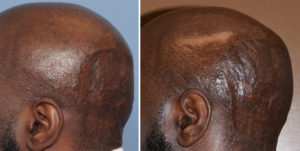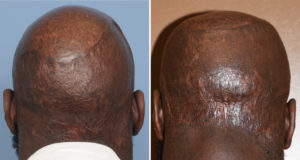Background: The shape of the head is largely determined by the underlying bone. This is certainly true from the brow bones back to the nuchal ridge on the bsck of the head. This is less true on the sides of the head where the temporalis muscle makes a significant part of its thickness.
But the scalp or the thickness of the overlying soft tissues on top of the bone also makes a contribution to its shape. Loss of part of the scalp’s thickness can cause contour deformities or indentations whose significance depends on how large it is. Most people don’t realize how thick the scalp is particularly in patients of increased skin pigment or in males. Scalps can easily be up to 2 cms in thickness in some patients
While soft tissue contour deformities almost anywhere else in the body is treated by soft tissue augmentation methods, like fat grafting, the scalp is not so easily injected. There is not a lot of fat in the scalp and its multiple layers are fairly adherent to each other. This makes for a difficult tissue plane to inject into which would be even more so in a scarred scalp with partial thickness loss.
Case Study: This African-American male had a history of chronic scalp infections from hair follicles on the back of his head. Due to its severity it was eventually treated by removal of the involved occipital scalp skin and reconstructed with a split-thickness skin graft. This cured his scalp infections but left him with an obvious contour deformity, making the neck of his head narrow and looking like a part of his head was missing.



In partial-thickness scalp defects contour improvement ca be obtained by a bone-based implant. It is important that the scalp is thick enough to allow it to be raised off of the bone while still maintaining good vascularity.
Highlights:
1) Contours deformities of the head can be caused by scalp thickness deficiencies.
2) A skull based implant can improve a head contour deformity caused by a deficiency of the overlying soft tissues.
3) The design of such a skull implant is based on external mesuremenst rather than a CT scan which can not accurately detect the 3D extent of the soft tissue deficiency.
Dr. Barry Eppley
Indianapolis, Indiana




